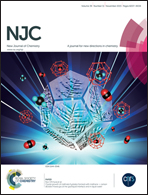A theoretical study of a series of novel two-photon nitric oxide (NO) fluorescent probes based on BODIPY†
Abstract
In this work, a series of novel nitric oxide (NO) probes and the corresponding reaction products are designed based on boron dipyrromethene (BODIPY) and heteroaryl-fused BODIPY or 3,5-distyryl substituted BODIPY (KFL). Furthermore, the mechanism of recognizing NO controlled by intramolecular photoinduced electron transfer (PET) is verified by theoretical chemistry computation in this work. More importantly, the two-photon absorption properties of these novel chromophores are explored by using DALTON program. The results of our study show that the two-photon absorption cross sections of the designed molecules are as large as 1056.9–39702.5 GM with the wavelengths ranging from 700 to 850 nm, especially for KFLs based on the 3,5-distyryl substituted BODIPY core, which have more potential for applications in two-photon absorption fluorescence imaging with larger two-photon absorption cross sections in the near-infrared region, because of their better rigidity and π-conjugation that are more conducive to intramolecular charge transfer. Finally, this work presents structure modification strategies for increasing two-photon response. We hope the study can provide helpful information for further investigating two-photon NO probes.


 Please wait while we load your content...
Please wait while we load your content...